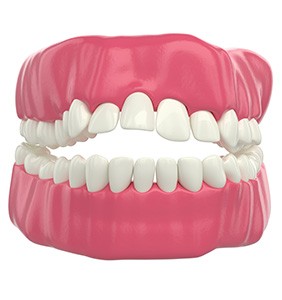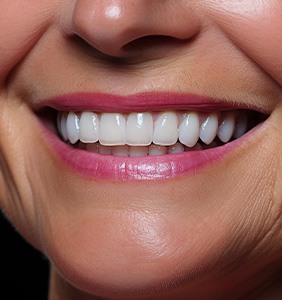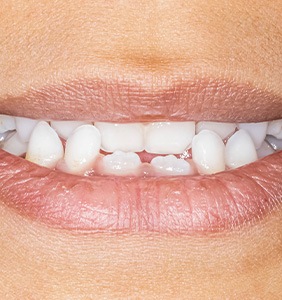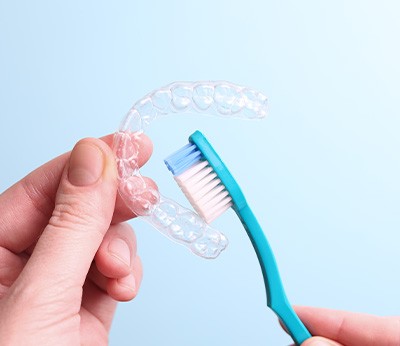Invisalign® Clear Aligners – Sugarcreek Township, OH
The Discreet Way to Straighten Your Smile

At Advanced Dentistry of Dayton, we understand the pressure that many working professionals face to have a polished, self-assured appearance. He also knows that this can be hard to achieve if you’re insecure about having crooked teeth. Maybe you’re interested in straightening your teeth, but not in wearing metal brackets and wires that shine a spotlight on your orthodontic treatment. We have many patients who are in the same boat, which is why we offer Invisalign clear aligners in Sugarcreek Township as the discreet way to straighten your smile. Please give us a call today to schedule your consultation!

Why Choose Advanced Dentistry of Dayton for Invisalign?
- Virtually Undetectable Orthodontic Treatment
- Friendly & Experienced Dental Team
- In-Network with Several PPO Dental Insurance Plans
How Invisalign Works

Instead of obnoxious metal brackets and wires, Invisalign uses a series of clear plastic trays to reposition the teeth. Each set of these trays, which you’ll wear for an average of two weeks, is designed to shift one section of your smile at a time until all of your pearly whites are properly aligned. Throughout the course of your treatment, you’ll visit us every six weeks or so in order for us to monitor your progress and give you the next few pairs of aligners.
The aligners are made from a smooth, transparent, and FDA-approved plastic material. Not only are they quite comfortable in the mouth, but most people won’t even be able to tell that you’re wearing the trays!
Who Can Invisalign Help?

Invisalign is a great treatment for patients who want to discreetly align their smile without the commitment of traditional braces. Invisalign can correct bite issues, small gaps, and even spacing issues, all without the need for hard-to-clean wires and brackets. Plus, it can often achieve the same results as braces in a fraction of the time.
Crowded Teeth

As you age, tooth crowding can become worse as your teeth shift. This can ultimately impact your oral and overall health by increasing your risk of developing many dangerous conditions such as:
- Cavities/tooth decay
- Gum disease
- Jaw discomfort or aching
- Difficulty chewing or biting
Crowding can also cause your teeth to overlap and create spaces that are difficult to clean within the mouth. This can increase your risk of bacteria, food, and tartar accumulation.
Invisalign aligners can shift your teeth to lay flush beside each other, making it easier to brush and floss and prevent damage and decay.
Finally, never discount the benefits of a straighter smile on boosting your self-esteem!
Gaps Between Teeth

There are many causes of gaps between the teeth, such as natural bone development, having “too small” of teeth, having a large jawbone, or many other natural factors. They may also appear as a result of thumb sucking or tongue thrusting in childhood.
No matter their cause, addressing gaps is best for your oral health, as it can reduce the risk of bacteria and plaque from building up, tooth decay, gum disease, and gum inflammation. Your dentist may choose to use dental bonding in addition to your Invisalign treatment to close any sizeable gaps.
Overbite

An overbite (or overjet) is an alignment problem which causes the top teeth to jut out too far from your lower arch. Overbites can frequently lead to jaw pain, speech problems, uneven tooth wear, and difficulties opening and closing your mouth. It can also leave your top teeth more exposed, putting them at greater risk for accidental injury.
Underbite

An underbite occurs when the bottom teeth go slightly past or match with your top row of teeth when your mouth is closed. Underbites are typically caused by genetics, oral trauma, or non-nutritive habits as a child (such as thumb or pacifier sucking).
If left untreated, an underbite can lead to many issues like an increased risk of sleep apnea, mouth breathing, and difficulties speaking and chewing. Underbites are most easily addressed in younger patients, but even in older adults it is still important to treat.
If you have an underbite, you may also need to use rubber bands or other attachments in conjunction with your Invisalign trays. This will help adjust your bite and pull back your lower arch while it aligns your teeth.
Crossbite

A crossbite occurs when the bottom teeth are slightly in front of your upper arch. It is typically caused by genetics, bad oral habits, or premature loss of your baby teeth.
Invisalign aligners can correct this issue, however, if it is due to an issue created by your jaw development you may need to combine elastics or other accessories to help shift your jaw into its proper positioning.
If not corrected, a crossbite can cause long-term problems like an increased risk of gum disease, tooth decay, jaw pain, speech problems, headaches, bruxism (teeth grinding) and even facial asymmetry, which can cause a lack of self-confidence.
Open Bite

An open bite refers to when the top and bottom front teeth can’t overlap or touch when you close your mouth completely. This problem is typically caused by poor bone development, or due to prolonged pacifier sucking or thumb sucking. It can frequently lead to difficulty pronouncing certain words and sounds, as well as excessive enamel wear on the back of your teeth.
Invisalign aligners can help bring the top and bottom teeth together, correcting your bite pattern and reducing the risk of dental damage and wear to your teeth.
Living with Invisalign Aligners

If you’re interested in Invisalign, but you want to learn more about it before signing on the dotted line, you’re in the right place. Below, you will find some helpful information about day-to-day life with clear aligners, including how often you need to wear them and habits you can adopt to keep them stain and odor-free. So, read on!
Wearing Your Trays

During your Invisalign treatment, you don’t just need to wear your aligners; you need to wear your aligners for 20+ hours a day. Initially, having a few hours of aligner-free time each day may seem like more than enough, but it’s not as much time as you think when you consider that you need to eat three meals and complete your oral hygiene regimen in that time frame.
Tip: While you work to find a routine that works for you, use the stopwatch on your phone so you can see how close or far you are from the mark!
Cleaning Your Aligners

One of the many perks of Invisalign is that the aligners are clear, allowing you to pursue a straighter smile without drawing unwanted attention to it. The key to keeping your braces basically invisible is committing to good habits, like rinsing them with water when you take them off and using a soft-bristled toothbrush to remove debris from the surface before putting them back on.
Tip: Don’t use hot water when you rinse or clean your aligners. Doing so can cause them to warp!
Eating & Drinking

Since Invisalign aligners are removable, there aren’t any dietary restrictions. There are, however, a few guidelines we recommend sticking to in an effort to keep your smile healthy and any attachments you have securely in place, like exercising caution with tortilla chips, popcorn, and other crunchy foods.
Tip: Fill your plate with softer, nutrient-dense foods, like bananas, plain yogurt, and scrambled eggs.
Losing or Damaging a Tray

If you accidentally lose one of your aligners or they break, don’t simply move onto the next set in the series, especially if you are still a week or two away from making the transition. Instead, call us ASAP so we can take a look at where you are in the teeth-straightening process and determine what the best way to move forward is.
Tip: Put your aligners in their designated case when you aren’t wearing them to prevent them from getting lost or damaged.
Attending Routine Check-Ins

Another important component of life with Invisalign is the check-in visits, which allow us to take new impressions and see how your teeth are moving. If you have been following the guidelines provided, like wearing the aligners for 20+ hours a day, then there’s a good chance that you’ll be on-track with your treatment plan and in and out of our office in 20 minutes or less.
Tip: Don’t forget to wear your trays to your appointment!
Benefits of Invisalign

The number of patients who have chosen Invisalign isn’t in the thousands; it’s in the millions. If you’re curious why clear aligners continue to be so popular year after year, then this next section is for you. You’re always welcome to schedule an appointment with us as well. We’d be more than happy to share all of the reasons Invisalign is right for you!
Virtually Invisible Braces

As the name implies, Invisalign trays virtually disappear once you place them over your teeth. That’s because they are crafted from smooth, see-through plastic, and they are custom-made from highly accurate impressions. In short, straightening your teeth doesn’t require noticeable metal brackets and wires anymore. Unless people know exactly what they’re looking for, your aligners should be almost unnoticeable.
No Dietary Restrictions

Whole apples, raw carrots, and other crunchy foods are a no-no with traditional braces. Since Invisalign aligners are removable, the same dietary restrictions do not apply. In fact, you can eat all of your favorite foods throughout the teeth-straightening process as long as you take them out first and brush your teeth before putting them back on. You can even take them out if you have a special event, like a date. Just remember to put them back in afterward!
It’s Easy to Take Care of Your Teeth (and Your Trays!)

It’s no secret that brushing and flossing with metal braces is a bit of a hassle. Like we mentioned above, Invisalign aligners are removable, so you don’t have to worry about dietary restrictions or cumbersome oral hygiene regimens. Even caring for your trays doesn’t require anything too extensive. As long as you rinse them with clean, cool water when you take them out and clean them with a damp, soft-bristled toothbrush after each meal, they should stay stain and odor-free!
No Soft Tissue Irritation

Unfortunately, metal brackets and wires are known for digging into the gums, cheeks, tongue, and lips. Although dental wax can help prevent soft tissue irritation like this, special oral hygiene supplies aren’t always within arm’s reach. The good news is that the smooth plastic of the Invisalign aligners should cause no irritation. So, your journey to a straighter smile will be significantly more comfortable.
Shorter Average Treatment Timeline

Oftentimes, traditional braces require two to three years to fully straighten teeth. Conversely, the average duration of Invisalign treatment is only 12 months. There’s a possibility that your orthodontic treatment will be even shorter too. Patients with mild cases of malocclusion sometimes only need to wear aligners for 3-8 months. When you come in for your consultation, we will provide you with an estimate of your treatment timeline. That way, you have a better idea of the time you’ll need to invest in the teeth-straightening process.
Understanding the Cost of Invisalign

Before committing to Invisalign treatment, you likely want to know how much it’ll cost to determine whether or not it’s right for you. Since every case is unique, it’s impossible to give an accurate price estimate until you come in for an exam. At Advanced Dentistry of Dayton, we’ll conduct a thorough oral examination and explain which factors will affect the total cost. If you’d like to learn more about what to expect, continue reading or get in touch with our team today!
Factors that Affect the Cost of Invisalign

The cost of Invisalign in Sugarcreek Township can vary significantly from person to person based on several factors, including:
- The number of aligners needed to straighten your teeth. Usually, this is directly related to the extent and type of dental misalignment you have.
- Whether you’re straightening one arch or both. Logically speaking, straightening both the upper and lower teeth will cost more than straightening just one or the other.
- Your treatment compliance. If you lose an aligner or fail to stay on top of your treatment plan, you may have to pay more than initially expected.
- Whether or not you need additional accessories. Depending on your case, you might need extra tools like elastics to ensure successful treatment.
Invisalign vs. Smile Direct Club™: Which Costs More?

Are you on a budget? If so, you may be exploring your do-it-yourself clear aligner therapy options. SmileDirectClub™ is extremely popular because it usually costs around $2,000, while Invisalign can run anywhere between $3,000 and $8,000. Even though the price point is certainly attractive, it’s important to keep in mind that you get what you pay for.
That said, here are some distinct differences between SmileDirectClub™ and Invisalign:
- DIY clear aligners are typically made of cheap plastic, while Invisalign uses a patented material designed for comfort and efficient tooth movements.
- Some people claim that SmileDirectClub™ has been ineffective or worsened their dental misalignment. In the end, they had issues that needed to be fixed by a professional anyway. On the other hand, Invisalign has proven to be consistently successful.
- One of the most significant disadvantages of SmileDirectClub™ is the lack of dental supervision. With Invisalign, you can enjoy the personalized support and guidance from our dental team throughout your entire treatment plan!
Does Dental Insurance Cover Invisalign?

Fortunately, most dental insurance plans offer coverage for orthodontic treatment, including Invisalign. If your policy applies, you can reduce your out-of-pocket expenses by $1,000 or more. Before committing to anything, make sure you call your insurance provider to confirm the details of your coverage. Our team is more than happy to help with that step if needed.
Options for Making Invisalign Affordable

Don’t have dental insurance? No problem! We offer additional financing options to help make your dental bills much easier to manage, such as:
- CareCredit Financing – With this option, you can split up the total cost of your treatment into smaller monthly installments. Plus, there’s often little-to-no interest attached!
- Savings Plan – For one low fee, you can get all the preventive dental care you need and gain access to sizeable discounts on other services like Invisalign.
Are you ready to start your Invisalign journey? Give our office a call and schedule a consultation today! We’ll help you meet your smile goals while keeping your total expenses as low as possible.
Invisalign FAQs
How Long Does Invisalign Take?
Naturally, the answer to this question varies. After all, each treatment plan is 100% customized to the patient! On average, however, Invisalign takes between 12 and 18 months. This is significantly different than traditional braces, which often take well over 24 months.
One of the biggest factors that will impact your Invisalign treatment timeline is how well you follow your orthodontist’s instructions. For example, if you diligently wear your aligners for 20-22 hours a day, your teeth are much more likely to “track” properly. On the other hand, if you constantly misplace your aligners or simply neglect to wear them, you’ll likely fall off-track with your treatment plan, requiring more time and money to be spent on Invisalign.
Does Invisalign Hurt?
One of the biggest perks of Invisalign is that the trays are significantly more comfortable than metal brackets and wires. With that being said, you can expect some minor soreness – your teeth are being moved into entirely new positions, after all! Luckily, you can easily alleviate any discomfort by placing a cold compress against the outside of your cheek or taking an OTC pain reliever.
What Happens After Invisalign?
Once you’ve worked through your entire series of clear aligners, you’ll be given a retainer. The good news is that this small orthodontic appliance is just as discreet, ensuring its presence won’t detract from the look of your smile. At first, you’ll most likely be instructed to wear it around the clock (about 20-22 hours a day) as your teeth “set.” Following this period, you’ll get the green light from your dentist to wear it solely at night. To help prevent orthodontic relapse, this should be a lifelong best practice.
Can You Eat with Invisalign?
While you can’t eat with your Invisalign aligners in, you can eat virtually anything you want once they’ve been removed. In fact, that’s one of the many reasons patients love this teeth-straightening solution: no food restrictions! Just be sure to indulge in sugary foods and drinks in moderation to prevent tooth decay.
What Are Invisalign Attachments?
In short, Invisalign attachments are pieces of tooth-colored resin that are securely bonded to your teeth. While they are small, they do play a large role in helping moderately to severely misaligned teeth effectively move into their new and improved positions. While some patients get their attachments at their very first visit, others work through their first few trays to begin with. Ultimately, the number of attachments you need and when they’ll be placed will depend on your unique treatment plan.





